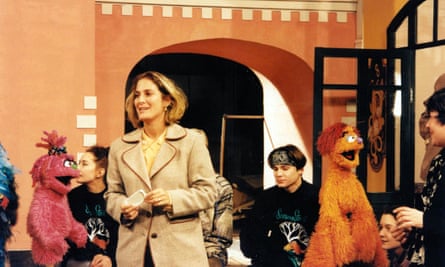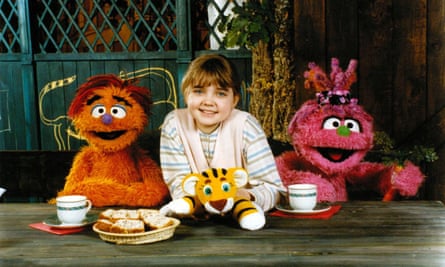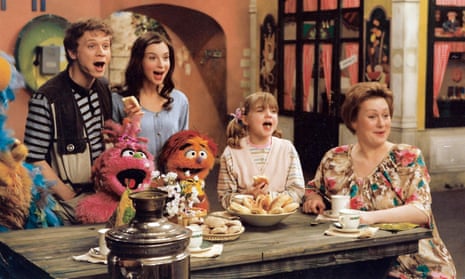It was Big Bird diplomacy. In his days as a US senator, Joe Biden led congressional support for international versions of Sesame Street, the educational show with muppets that had transformed children’s television in America.
From Mexico to India, from South Africa to Northern Ireland, there have been co-productions of Sesame Street specifically tailored to a local audience. So when the cold war ended in the early 1990s, Russia and other former Soviet republicans beckoned like cookies to Cookie Monster. What could possibly go wrong?
The “unexpected crazy true story” of Ulitsa Sezam (Sesame Street in Russian) is told by Natasha Lance Rogoff in a highly entertaining and readable new book, Muppets in Moscow, which recounts a litany of cultural clashes, wild west-style assassinations and dashed hopes about the post-communist era.
“These stories are a deep dive into Russian culture and an experience where Sesame Street’s progressive values are pitted against 300 years of Russian thought,” Lance Rogoff, 62, says by phone from Aspen, Colorado, where she is attending a conference. “Through the experience of struggling to create a version of Sesame Street in Russia you’re able to grapple with the tensions that exist in post-Soviet society that we’re still dealing with today.”
Lance Rogoff was the perfect choice to become lead producer of Ulitsa Sezam and bridge the cultural divide. As a teenager in New York, she fell in love with Russian literature and even changed her legal name from Susan to Natasha. She studied Russian in college and, at 22, moved to Leningrad (now Saint Petersburg) as an exchange student.
She befriended artists and dissidents and wrote articles about underground culture in the Soviet Union for international magazines and newspapers. These included the groundbreaking Gay Life in the Soviet Union in the San Francisco Chronicle in 1983. That same year she married a gay friend to help him escape persecution by the government (“I just felt at that age that I had to do something,” she explains).

The marriage ended after three years but would change the course of Lance Rogoff’s career, effectively ending her ambitions to become a diplomat. Back in the US, she studied at Columbia University’s School of International and Public Affairs and was selected for a fellowship at the state department, which required high-level national security clearance.
But at FBI headquarters, she overheard the agent conducting her interview tell a colleague in a southern drawl: “There’s no way this gal’s gonna work for the guver’ment of the U-nited States of America. She combined two things that are a no-no: commies and queers.”
Her clearance denied, Lance Rogoff returned to Moscow and found work as a TV producer. Then, in 1993, came the call from Sesame Workshop to make Ulitsa Sezam – the start of a four-year odyssey working with hundreds of directors, musicians, writers, producers, set designers, puppeteers, animators and actors.
She soon discovered things that had been divided by an iron curtain were still at odds. For a start, while Ronald Reagan and Mikhail Gorbachev had discussed many things, including intermediate-range nuclear missiles, they never signed a muppets treaty.
“When we were developing the Slavic muppets, the creative team initially said, ‘We don’t want your muppets; we have our own revered puppet tradition dating back to the 16th century,’” Lance Rogoff recalls. “Eventually, after several months with the help of some of the team members who really loved the muppets, we got them to begin designing their own muppets.
“Their first design for Ulitsa Sezam was an old man with a beard who would tell children what they needed to know and how to behave in new Russia. I said, ‘Wouldn’t it be better if the character was a child so children could really relate to the muppet?’ The head writer at that time said, ‘You can’t expect children to learn from children’. Everything was a process.”
There were also moments when capitalism collided with the legacy of communism. Lance Rogoff continues: “It was a very humbling experience because I realised how little I understood about Russia in the process of designing the content for the series.
“We were at a curriculum seminar in the Danilov monastery in Moscow and there were about 40 educators from across the former Soviet Union. Everybody’s talking about what do we want to teach? How do we teach our children about this new society? We’re all throwing around ideas and I suggest, what about writing a scenario where children are running a lemonade stand, and the reaction to that uniformly was it would be shameful to show children selling things on the street.”
She adds: “There was a whole argument about the word ‘business’ and should we be teaching children to engage in business? You cannot assume after 70 years of communism that we’re just going to flip a switch and people are suddenly going to be able to even conceptualise what a new, more open society looks like.”

At first the head writer of the show only wanted to hire established authors of Soviet children’s literature. But these writers turned in scripts that were 10 pages long and too abstract for kids to understand. Lance Rogoff says: “The scripts that we got to teach geography were almost 100% about leaving Russia, like going off to France and eating foie gras.
“We were teaching the concepts of happy and sad and there’s a little boy and a little girl who are holding a balloon and walking together in the park, and the little boy accidentally lets go of his balloon.
“He starts crying and the little girl looks at him and he’s upset so she lets go of her balloon too. Then they stand there together and watch the two balloons go up in the sky. As an American looking at this I’m like, well, that’s kind of nuts, why don’t they just share the other balloon?
“Then I realised this script was a quintessentially Russian script. It was about the beauty in sharing having nothing together. It reminded me of the Tolstoy story Master and Slave. There were many moments related to script writing that were really unexpected.”
To top it all, production unfolded amid the whiplash of post-Soviet Russia’s sudden switch from communist to free market capitalism, an uncertain period of food shortages, lawlessness, lost livelihoods, political chaos and pitiless violence.
Several heads of Russian television, with whom Lance Rogoff was closely collaborating, were assassinated one after another. Among them was Vladislav Listyev, a prominent TV journalist and democracy advocate (his 1995 murder has never been solved).
Lance Rogoff had spent months negotiating – and drinking – with Listyev to get Ulitsa Sezam on air. “He was our confidante, sharing advice with us about how to navigate the Russian TV industry; advertising was very corrupt at that time. The day that we went to the TV station and discovered that that he had been gunned down the night before was absolutely shocking and left me wondering if it was really possible to continue.
“There were so many courageous men like him who were trying to create a free press and also trying to stamp out corruption and create a society for children.
“When I first met him, he said he knew about Sesame Street and then he said it’s never more important than now: our children need to develop new new skills and values in order to be successful in the world. He did as much as he could to help us as we were trying to assemble the team and raise the money and all the other things we were doing.”
On another terrifying occasion, Russian solders armed with AK-47 rifles descended on Lance Rogoff’s production office and confiscated scripts, set drawings and even the office mascot: a life-sized Elmo. “I asked the Russian executive producer, ‘Why did they do that?’ And he was like, ‘Oh, he probably has a son, you know?’”

Despite it all, Ulitsa Sezam made it to air in October 1996 starring Zeliboba, an 8ft-tall hound-like animal with floppy ears, long muzzle and keen sense of smell – he could even smell music. Lance Rogoff produced 52 half-hour episodes broadcast over two years. It was a big hit.
She recalls: “The night that the show airs, I go outside and I can see with my colleague all the colours changing in unison in the windows of the apartment buildings. We realise that they’re watching the show because there was so much press about it before it came out.”
Ulitsa Sezam ended in 2007 but the memory lingers on for a generation of Russians as Lance Rogoff, now based in Cambridge, Massachusetts, discovered when she last visited the country two years ago. “I checked into the the hotel and I always ask people, if they’re in their 20s and 30s, do you know Ulitsa Sezam? The two women shrieked and started singing one of the songs.
“I’m so proud of what we accomplished there and it’s heartbreaking now to be in touch with my colleagues on WhatsApp. So many of them had to flee after the war [in Ukraine] started because of their opposition to it.”
McDonald’s arrived in Russia in 1990. Gorbachev, the last leader of the Soviet Union, famously featured in a 1997 TV advertisement for Pizza Hut. Looking back, it seems like too much too soon, another failure of western imagination. Gorbachev died last month but lived long enough to see Vladimir Putin undo much of his legacy, culminating in the unprovoked invasion of Ukraine and committing of heinous war crimes.
Lance-Rogoff reflects: “From my experience making Sesame Street there, I understood how important it was to take into account Russia’s historical background, their difficulties, the fact that they were transitioning and transition takes time. It takes time for consciousness to change and the expectation of doing shock therapy capitalism was very fast for average people living in post-Soviet society who were grappling with incredible pain.
“At that time, policy was very heavily focussed on macroeconomics and stabilising the ruble and there were many people in Congress, including Senator Biden, who understood the value of soft power in helping nations to develop the cultural capital to be able to make some of these larger changes.”
The author wonders: “Maybe it was our exuberance to see ourselves in the other and not recognising how historically different our experiences are: us with 200 years of democracy and Russia with their tragic history of turmoil and constant instability. People are human. People can only take so much turmoil.”
Muppets in Moscow: The Unexpected Crazy True Story of Making Sesame Street in Russia is out now
